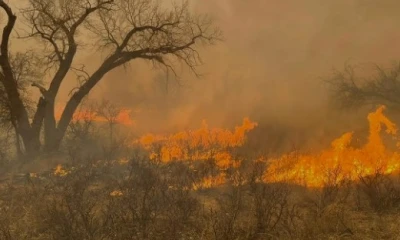In a devastating turn of events, the Texas Panhandle and the Northern Plains find themselves engulfed in the wrath of wildfires, exacerbated by scorching temperatures and fierce winds. Dubbed “Lucifer’s wrath,” these wildfires have already laid waste close to 900,000 acres of land, forcing residents to abandon their homes, closing roads, and even necessitating the shutdown of a nearby nuclear weapons facility.
The most formidable of these fires is the Smokehouse Creek Fire, raging north of Stinnett and currently spanning a staggering 850,000 acres — marking it as the second-largest fire in Texas history. Its rapid spread, from 300,000 acres just the day before, highlights the severity of the condition. Temperatures soared to a blistering 126 degrees Fahrenheit (52 degrees Celsius), compounding the challenge faced by firefighters.
Despite the tireless efforts of emergency responders, the cause of the fire remains elusive. However, yesterday offered a glimmer of hope as cooler temperatures without wind enabled firefighters to make some headway in containing the inferno.
There’s a flicker of relief on the horizon as forecasts predict light snowfall on Thursday, originating from a weak storm drifting in from New Mexico. Yet, this respite may be short-lived, with conditions set to deteriorate once more come Friday. Temperatures are forecasted to surge to 70 degrees Fahrenheit (22 degrees Celsius), accompanied by gusts exceeding 30 mph and dangerously low humidity levels below 20 per cent.
Recognising the gravity of the situation, Texas Governor Greg Abbott swiftly declared a state of disaster for the 60 counties ravaged by the wildfires. Urging for heightened resource allocation, Abbott stressed upon the need to bolster support for local firefighters battling the blazes on the front lines.
Among the communities impacted by the flames is Canadian in Hemphill County, where an automated weather station fell victim to the inferno. The station, operated by the West Texas Mesonet, recorded temperatures soaring to 126 degrees before succumbing to the fire’s fury. Additionally, the fire’s relentless advance northward towards Pampa, driven by gusts reaching 40 to 50 mph, poses further threats.
In a chilling development, the proximity of the flames prompted the temporary cessation of operations at a nuclear weapons facility near Amarillo. Pantex, the facility’s operator, assured the safety of all employees while firefighting teams worked tirelessly to safeguard the property from encroaching destruction.
Adding to the turmoil, the North CIG Fire erupted along CIG Road, initially spanning 750 acres before ballooning to over 4,000 acres by Sunday night — a stark reminder of the relentless onslaught of wildfires plaguing the region.
As communities grapple with the aftermath of devastation, the resilience of Texans is put to the test, underscoring the urgent need for coordinated efforts to mitigate the impact of these catastrophic fires.

















